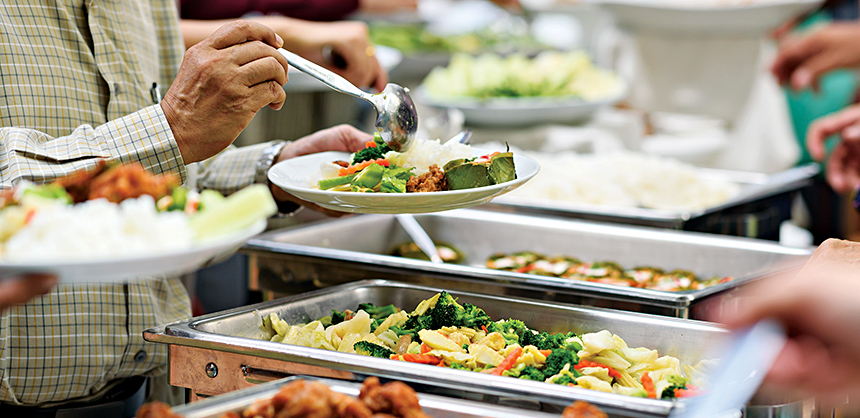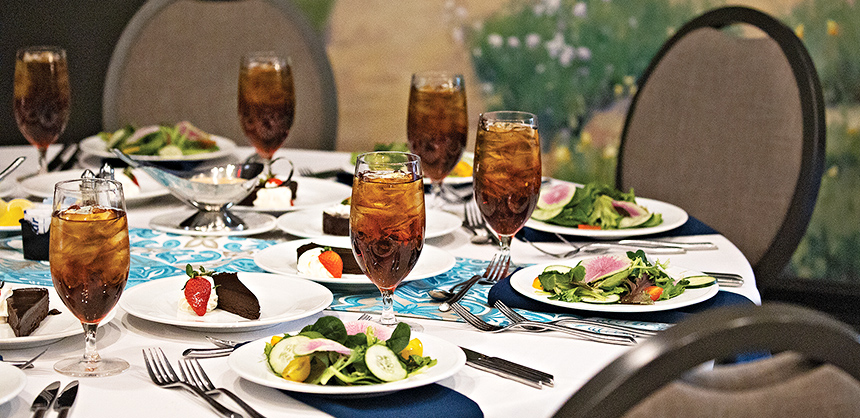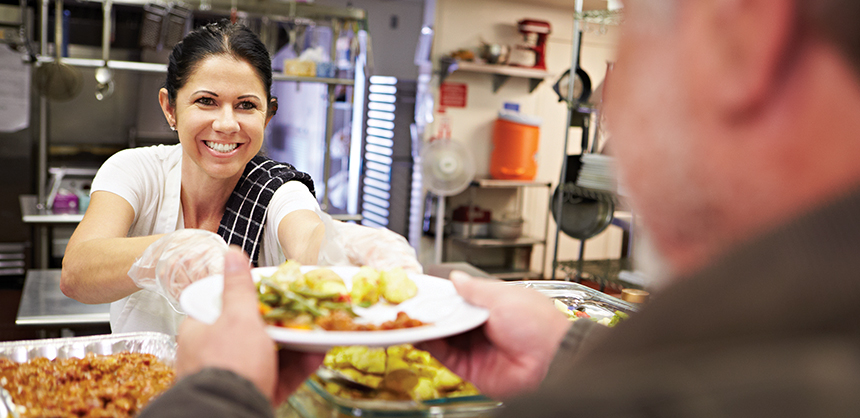Fighting Food WasteMay 15, 2023
More Planners Are Using Plant-Based Menus, Smaller Portions and Local Food Banks By Keith LoriaFighting Food Waste
More Planners Are Using Plant-Based Menus, Smaller Portions and Local Food Banks
DepositPhotos.com
Nobody likes to waste food, especially when there are solutions available.
Each year, some 119 billion pounds of food is wasted in the United States, which equates to 130 billion meals and more than $408 billion in food thrown away, according to Feeding America.
Food waste is also a significant problem at corporate meetings and events. First, it indicates money has also been wasted, which affects a company’s bottom line. But it also shows the company isn’t thinking about what’s best for the planet.
Over the years, food waste solutions in meetings and events have evolved from simply asking attendees to be mindful to more innovative practices.
“Food waste is a big problem in the world in general, and as an event planner, it’s my responsibility to implement solutions to limit food waste at my events,” says Talita Trygsland, an event professional with over a decade of experience planning and producing corporate and entertainment events. “I choose plant-based foods at my events, making it easier to handle and donate the food after the event. I work with nonprofits, food banks and city projects to pick up or receive, and donate or compost, any food leftovers after the event.”
An easy solution is to offer smaller meals or allow attendees to choose their portions, reducing the amount of uneaten food. Another is to donate leftover food to local shelters or food banks. Some event planners even partner with local farmers to repurpose food waste as animal feed or compost. These solutions not only minimize waste, but also promote sustainable practices and community involvement.

An easy solution to eliminating food waste is to offer smaller meals or allow attendees to choose their portions, reducing the amount of uneaten food. Photo Courtesy of Stephanie Scheller
Savvy Strategies
Kirsten Gooden, vice president of production at Stratus Firm, which has been producing large events for more than a decade, including the Congressional Black Caucus Phoenix Awards and The Helen Hayes Awards, has seen the evolution of food waste solutions for the better.
“Food waste is an issue that has become tied to the environment and the critically important goal of improving the world around us for future generations,” she says. “Sustainability is something that we focus on at Stratus but also many of our vendor partners do as well. Clients have also shifted their focus and many expect that sustainability will be a focus throughout the planning process.”
Last spring, Stratus Firm produced a world premiere screening of “We Feed People,” a documentary directed by Ron Howard about the World Central Kitchen and its founder, Chef Jose Andres. With its catering partner for the event, Occasions Caterers, the Stratus Firm team worked to identify and transport leftover food to local organizations and food banks.
“In addition, many of our catering partners have partnerships around the DMV areas with food banks and community centers where donations post-event can be taken,” Gooden says.
Butchers Tale, a popular restaurant in Minneapolis, regularly hosts corporate meetings and works with numerous meeting planners on events.
“I know of one planner who has begun to err on the side of caution,” restaurant CEO Kam Talebi says. “She registers everyone who is going to eat, fines no-shows, records them, and only uses small plates and portions. She explains the portions to the attendees and asks them to predict how much they will consume.”
As a result, the food waste was reduced by 50%. That’s one of the best percentages Talebi has seen from his years in the business.
“The only absolute solution is to make everyone responsible for feeding themselves, but every social event revolves around food,” Talebi says. “That’s not an option. That’s an idea. Turn the food part of an event into a cash bar and cook to order.”
Solutions Involve Menu Selection, Recycling Programs and Locally Sourced Food
Bonnie Whitfield, human resources director for Family Destinations Guide, is responsible for organizing and facilitating various meetings, ranging from employee training and performance evaluations to departmental collaborations and executive leadership meetings. One of her responsibilities is to ensure that there is as little food waste as possible.
“I consider minimizing food waste an important aspect of a meeting because it can be cost-effective,” she says. “Additionally, minimizing food waste can contribute to the reputation of our company. Our company is committed to social responsibility, and our actions reflect that. By reducing our food waste, we demonstrate that we are responsible stewards of the environment and resources, and we hope to inspire others to do the same.”
She does this by only ordering the necessary amount of food for each meeting, taking into account the number of attendees and their dietary restrictions; by encouraging participants to take only what they need and to return for seconds only after everyone has been served; and by partnering with a local food bank to donate any leftover food to those in need.
“I think meeting planners can improve their food waste solutions in several ways,” Whitfield says. “One of the biggest areas for improvement is menu planning. By working with caterers or food providers to plan menus that incorporate locally sourced and in-season ingredients, meeting planners can reduce food waste, while also promoting sustainability. Implementing composting and recycling programs can also ensure that any unavoidable food waste is disposed of in an environmentally responsible way.”
At Family Destinations Guide’s last executive meeting, it used several food waste solutions. “We ordered only the necessary amount of food and partnered with a local food bank to donate any excess food,” Whitfield says. “As a result, we were able to reduce our food waste by 40% compared to last year’s executive meeting, where we did not have any food waste solutions in place. Not only did this minimize our environmental impact, but it also allowed us to make a positive contribution to the community. It was a win-win situation for everyone involved.”
Stephanie Scheller, founder and CEO at Grow Disrupt, which produces educational and inspirational events and meetings, notes that controlling costs is a necessity for most meetings and events today, so controlling food waste is critical to maintaining the longevity of events and ensuring they aren’t money pits.
“It’s also important to be thinking about the long-term impact and the green impact,” she says. “This is becoming more and more important for buyers to spend money with people who aren’t hurting the planet. So, having a huge amount of food waste is likely to result in a PR nightmare down the road for most events.”
While catering companies are typically in control of what they do with the excess waste, many take part in composting and recycling, but it’s still up to them. That’s why Scheller always makes sure to interview them carefully to determine what they do before she decides to buy from them, only going with those who have sustainable practices in place.

Los Angeles-based event planner Marley Majcher suggests partnering with a local church and finding ways to distribute the food to them so they can give it to those in need in their community. DepositPhotos.com
Tips for Sustainability
For a conference or event to be more environmentally friendly, controlling food waste is crucial. Food waste can be substantial in the events industry because it can be difficult to cater to a precise number of attendees and their variety of tastes.
One of the best tips planners share is wisely planning the menu.
“Plan for upfront lessening and downstream deviation,” Trygsland says. “Find ways to prevent food waste and redirect it. Consider packaging, histories, service styles and guarantees when menu planning. Attendees, break times and event type must be considered when estimating food volume. If catering is scarce, you can increase lunch or coffee break food quantities, but not decrease. Avoid ordering global numbers and order individually for each coffee break or lunch.”
Marley Majcher, a corporate event planner based in Los Angeles, regularly plans meetings and events for celebrities and Fortune 500 companies.
Her tip for preventing food waste is to check the numbers.
“This sounds basic, but try to get the most accurate food count as possible,” she says. “For example, maybe you have appetizers at a cocktail hour then a sit-down dinner. Get a clear idea of how many people will actually be at both events and explain to your client that you are trying to combat food waste.”
Several planners championed the idea of measuring the quantity consumed and reporting the amount used during past conferences and events, which can lead to more sustainable practices. “Once you know the average consumption during each event held in the past, you will be better positioned to minimize food wastage for your current event,” Trygsland says. “You should ideally also measure cost impact, organic waste and food donation options. Besides donating, you may also divert food wastage towards composting.”
Create a Food Waste Log For Better Planning
Managing a waste log is also a great way to record what you are throwing away. This will help planners calculate the value of food loss. Maintaining this log will ensure that one makes better decisions in the future. As a viable alternative, a planner can also pass on certain foods ideal for canning and pickling to companies that undertake this.
Yes, running out of food is a planner’s worst nightmare, but they also have a responsibility to ensure that they are not wasting food and to also be good stewards of the client’s budget.
“Be mindful of over ordering,” Majcher says. “We want to ensure that [attendees] are fed, but by having an accurate count and ordering based on that count, you can help combat food waste and also keep costs down.”
This starts by talking to catering partners about the amount of food that is being proposed for an event. Yes, you want to have variety but when working through a menu, you want to make sure that it’s not too robust and does not include options that people won’t eat.
“Track attendance at client events and use this as a tool for future events and planning,” Gooden says. “If a client expects 800 to attend their cocktail reception and only 700 show up, when planning the next event, make sure you have an open dialogue about the attendance from previous functions.”
It’s also a good idea to go local. When working with a catering partner, explore adding menu options from local farms or service providers.
Scheller says tracking actual food waste at events in a dashboard or spreadsheet can make it easier to find the trends and adjust buying patterns for future meetings. Additionally, having a plan B to buy locally, if the brought-in options aren’t sufficient, can alleviate the stress that leads to over ordering.
“In previous years, we’ve had 30% to 50% waste in terms of meals and snacks, and that’s not even considering the waste generated by single-use containers,” she says. “This year, we cut the overall waste down significantly and cut our food waste down to 3%.”
The best advice for planners is to communicate with clients and vendors well in advance of their event, and find solutions for issues tied to over-ordering. Some clients share the fear of not having enough food, but if you have a trustworthy catering partner and an accurate attendee count, there is no reason to worry.
“Some clients may over order to account for a last minute jump in ticket sales,” Gooden says. “There are many reasons why over ordering happens, but if planners, clients and vendors work together and communicate, we can find better solutions and also save money.”
Corporate event planner Majcher notes bread is one of the biggest areas of waste and suggests keeping a clear count on bread numbers and find a group that can legally pick up any uneaten bread after the event.
“Share the wealth; find out if there is a local food bank or shelter that can take the leftover food,” Majcher says. “Just be sure to box it up and have a plan in place for those who don’t show up, and instead of having food sit untouched, provide boxes and have the venue package them up and then donate to a shelter after the event.”
She also suggests partnering with a local church and finding ways to distribute the food to them so they can give it to those in need in their community.
Venues Can Play a Part
The Indiana Convention Center has a number of initiatives to combat food waste after corporate meetings, but also has programs in place to help before an event.
“To avoid having food waste, Sodexo Live! uses historical data to help determine the amount of food to prepare,” says Nate Swick, senior communications manager for Visit Indy. “The data can be internal data from when the event was in the building last or data from other Sodexo Live! convention center and other properties that have hosted the group.”
Sodexo Live! works by collecting a lot of post-event data on groups, including the amount of leftover food, so it can be used for planning future events.
“When they do have leftovers and they can do it based on health and safety standards, Sodexo Live! donates leftovers to Second Helpings, which distributes food free of charge through local-social-service agencies in Greater Indianapolis,” Swick says.
Local Hunger Groups Can Help
While preventing waste from the start is ideal, it’s vital to prevent wasted food going to landfills. Consider food donation programs. For instance, Second Harvests gives healthy leftover food to the needy in several cities and countries.
Addressing food waste often requires a comprehensive approach based on data. Therefore, technology is integral in providing the insights to planners, while also assisting in everyday management strategies.
Preventing food waste is a top priority for HUNGRY Food Solutions, a marketplace powered by top chefs and proprietary technology to deliver curated food solutions for business and event catering.
When working with meeting and event planners, HUNGRY provides a personal concierge who is an expert in portioning food for large groups.
“Not only do we donate one meal for every two served to those in need, we also work with local companies like Goodr in New York to deliver leftover food from our corporate clients to local shelters,” says Jon Ebner, regional market manager for HUNGRY. “Outside of that, it is always nice to personally take extra food and give it to a homeless person on the street.”
Also, due to the restrictions of redistributing food, clients should be made aware that unopened containers can be distributed while others cannot. So, before having a taste of one piece of a dish, attendees should remember that this prevents the rest from going to those in need. “We have seen several clients donate a more significant amount of food due to increased awareness of food redistribution restrictions,” Ebner says. “In addition, HUNGRY and its team of food experts make sure to adjust portioning after each and every meal.”
You should also donate food in suitable containers for later consumption. Labeling leftovers helps you track food waste and food donations.
Catering Industry Works to Distribute Large Food Donations
John Brooks, president of BTTS Holdings, a conference and banquet facility in Westerville, Ohio, has long been working to solve the problem of food waste for his company. He has found it to be a big challenge but one he has worked hard to rectify.
“For us, in the catering industry, it stems from the cardinal rule of never running out of food,” he says. “Nothing puts a caterer out of business faster than a reputation for not having enough food at an event. Quite often, we prepare buffets for large-scale, high-end events. You have to prepare more than enough food based on industry averages. We always send extra, just in case.”
Brooks notes candidly that his team has worked hard to tackle food waste in various ways.
“Caterers are simply not setup to distribute excess food from large scale events,” he says, “Between our five venues, we typically average 12-plus events a week with over 1,800 [attendees]. We would reach out to many homeless shelters, food pantries and nonprofit organizations, but they were not set up to handle large-scale donations of already prepared food.”
The challenges, he notes, includes food licensing issues, timing, logistics and a lack of labor to help facilitate. But, then something changed. A few years ago, BTTS Holdings teamed up with Food Rescue US when it opened its Columbus, Ohio, chapter.
“Food Rescue US has built a bridge between us, as a leading event venues and catering company, and local nonprofit organizations all throughout central Ohio,” Brooks says. “That connection and partnership has led to us being able to have excess food from our clients’ events taken to various organizations in need throughout central Ohio. We are on pace to donate over 12,000 high quality meals in 2023. Understanding creates empathy. As a catering company, exposing this issue to clients allows them to be part of the solution. We can have an unforgettable event, while balancing the desire to not be wasteful.” | AC&F |








